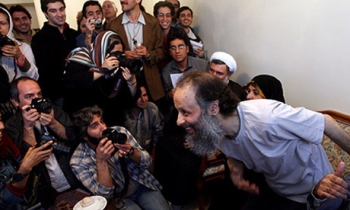Would you be reading this story if it were displayed on a 2-by-2-inch screen on your BlackBerry?
How about if it were electronically printed on a video scroll that spooled a few inches out of the side of your cell phone? Could you tell what was in the tiny picture?
Now. Would you read this story if it were electronically printed on a paper-thin video screen the size of a tabloid newspaper, or maybe something bigger, like The Washington Post, and resembling a vinyl placemat, like the image you see under these words? What if this new electronic paper could be folded under your arm like your dad's sports section or rolled up inside your yoga mat?
As newspapers fight declining circulation and face rising newsprint costs -- and their corporate owners demand wider profit margins -- editors, publishers, reporters and technologists have worked over the past few years to devise new, paperless ways to deliver the news.
But the change stretches beyond the physical delivery system. Reread the preceding paragraph. The tone is formal and authoritative. It is aloof and addresses no one in particular, as in a textbook or a lecture. It is newspapery.
The two paragraphs above it are chatty and inquisitive, provocative rather than definitive. They call attention to themselves and speak directly to you. Their tone is usually not considered appropriate in a newspaper, and certainly not atop a news story. Their tone is more at home on the Internet, with blogs and discussion groups and webzines.
Storytelling will change, as well. Long articles such as this, with complete sentences and linguistic device, likely will dwindle in number and be restricted to the remaining newspapers and e-papers. News on small screens, such as that of your cell phone, will spit out in headlines and blurbs and sentences without articles: "Mars rodent attacks NASA probe."
Russell J. Wilcox, chief executive of E Ink Corp., a spinoff of the Media Lab at the Massachusetts Institute of Technology, is working on the technology part: a paperless newspaper delivery system.
His business creates paper-thin video screens that, in simplest terms, are filled with tiny black and white chips. When an electrical current with data is sent through the screen, the chips become charged and arrange themselves into a pattern of black type on a white background. When readers want to flip to the next page, the particles scramble and rearrange.
In a Tuesday interview and discussion on the future of newspapers on washingtonpost.com, Wilcox said his company is working on adding color to the flexible black-and-white screen. Adding video and sound, he said, is at most 10 years off. Newspaper companies such as Gannett Co. and Hearst Communications Inc. believe in the idea enough to be investors.
For years, newspapers have thought of ways to deliver their news -- and brand -- in as many formats as possible. But they have found, from reader surveys and intuition, that the centuries-old newspaper size provides an optimal viewing experience.
"We think the essence of newspaper is the large size," Wilcox said during the interview. "[As] a reader you're an eagle flying over the desert, you're scanning. You see the rabbit and you zoom down and you grab it," reading a story that grabs your interest.
Because the Internet provides an instant two-way exchange that newspapers cannot, papers are using it to ask readers not only how they want their paper but what they want in it. Even if papers don't ask, feedback can be instant, via blogs, e-mails and discussion groups. And it goes the other way, as well. When newspaper reporters take to their papers' Web sites for discussions or other reader exchanges, they tend to adopt the Web's laid-back patois.
In this way, the Web may change the tone of newspaper writing, as in this story. Among mainstream communications outlets, newspaperese is pretty much the last outpost of such strictly formal use of English. Think of how your nightly newscast sounds -- anchors speak of "your neighborhood," for instance. Now think of how many times real people use common newspaper words such as "slate," as in, "I'm slated to see a 7 p.m. showing of 'Wallace & Gromit.' "
But not everything on the Web is chatty.
Tuesday's online discussion stirred some interest among bloggers, many of whom see themselves as alternatives -- and, sometimes, superior -- to traditional news outlets. The "Annotated Life" blog (which washingtonpost.com linked to) wrote, with some indignation: "The truth is that media corporations are not in control of the exploding online population, and it is frightening to those in ruling circles who have much to hide from the people at large."
Rather than hide from the people at large, I (there's something you usually don't see in newspaper stories) asked readers how they use newspapers and the Internet during Tuesday's Internet discussion.
Complaining that her local paper is late on news that she's already seen on the Internet, that stories raise more questions than they answer and the paper as a whole is of little relevance to her, Linda Loomis of San Antonio e-mailed yesterday to say that she often ends her days thusly:
"I throw down our local fiber newspaper in disgust, as I do most days when I'm reading the San Antonio Express-News, and exclaim to my husband (the subscriber), as I do most days, 'I'm going upstairs, online, for the real news.' "
Bill Breen is a delivery foreman for the New York Times and, at 59, wrote in an e-mail, "I know what the dinosaurs must have felt like, when it started to get cold."
A big newspaper such as the Times or the Wall Street Journal can go through 200,000 tons of newsprint per year. Now that newsprint has matched its historical high of $625 per metric ton, Breen understands the savings that would result if Wilcox's video-screen newspaper catches on.
"Why in their right minds would the Sulzbergers [the family that controls the Times], or any owners, pay for huge printing presses, fleets of trucks (burning a lot of expensive diesel fuel, by the way), warehouses and union drivers, if the need was not there?" Breen writes.
But many readers use both the paper and electronic versions of newspapers, they write, portending a future of co-existence.
"And the Sunday paper," writes Takoma Park's Abigail Grotke, "who would want to read all of that online? Not me. I need it in hand with the cup of coffee on a relaxing Sunday morning."









